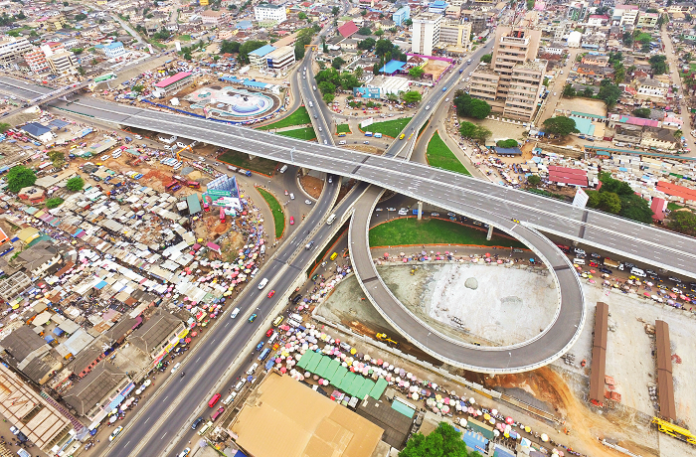
A warden during a rush hour stands to control vehicular movement at a road intersection with malfunctioning traffic lights.
The go-slow nature of traffic angers drivers who are seen honking their vehicles in an asynchronous manner.
‘Smart’ drivers on the blind side of compatriots try to meander their way by crossing lanes of the road causing more chaos on the road.
Motorcycles with improvised narrow lanes on the road also compete with crossing pedestrians, beggars and hawkers who take advantage of the traffic situation to cash in.
From the view of a passenger, structures are seen marred with graffiti artwork and posters of political personalities and upcoming events.
On the wayside is a charismatic preacher with his microphone spreading the gospel on the street.
Nearby is a chain of hawkers with their displayed wares hoping to get the attention of pedestrians who may patronise their ware.
In proximity is a heap of refuse which are being loaded to a waste truck.
As the world looks in on the city of Accra to mark World Cities Day, these are the familiar sights and sounds associated with everyday life on the streets of Accra
Accra as a coastal city with fine beach resorts can boast of interesting tourist locations and monumental structures, inherited during and after the colonial era.
Of such places are the Christiansburg castle, the Ussher and James Forts, National Museum, and the Kwame Nkrumah memorial park.
Accra gained its city status on June 29, 1961, despite being the capital of Ghana since 1877 after it was transferred from Cape Coast.
The United Nation’s 2016 World Cities Report estimated Accra’s population to be 2.3 million at a growth rate of 2.4 per cent.
The Accra Metropolitan Assembly (AMA), however, suggests that an additional population of two million people converge in the city on a daily basis for socio-economic activities.
This year’s theme of World Cities Day, “Building Sustainable and Resilient Cities” coincides with the Assembly’s vision of “building a Smart, Safe, Sustainable and resilient modern city”.
The relatively large population size nevertheless poses a challenge to the Assembly’s vision as well as its mission of “improving the quality of life of people living within the city while maintaining a clean, attractive and secure environment”.
Also at risk is the president’s vision of making Accra the Cleanest city in Africa.
Resilience Assessment
In April this year, the Assembly released a Preliminary Resilience Assessment report of Accra to assess the capacity of inhabitants to survive, adapt and grow irrespective of chronic stresses and shocks experienced.
After engaging 228 residents of Accra, it was revealed that stresses of the city manifest in high cost of living, inefficient public transportation as well as water scarcity.
Also mentioned is the poor waste management and sanitation which is managed through a polluter-pay policy where the cost of disposing of waste is paid by those who generate it.
The city on a daily basis is known to generate about 3000 metric tonnes of waste of which 70 per cent is collected by formalised waste companies.
Informal waste collectors collect and dump some 25 per cent of the remaining waste at designated transfer sites while remaining 5 per cent is disposed of by residents who either burn, bury or dump them at inappropriate places such as drainages.
Shocks
The Assessment also identified Accra’s priority shocks which are defined as sudden, sharp events that threaten a city to include fire, disease outbreak, infrastructure collapse and earthquakes.
Regardless of Accra having a relatively low rainfall average of 809 millimetres annually, perennial flooding also remained a threat to the city’s resilience to shocks.
Flood is caused by rapid urbanisation, improper waste management, erosion and sedimentation, poor drainage capacity and improper settlement along water bodies.
Flooding has often led to the loss of lives and economic damage of properties running into millions of cedis.
A study on flooding in Accra titled, “Impact analysis of flood in Accra,” was conducted after the June 3, 2015, disaster that led to the loss of 152 lives.
The study found Accra to have a high flood occurrence rate of 17-20 per cent with more than 20 per cent probability of inland flooding in any given year.
A sustainable approach to Flood Risk Management was recommended.
This involved adopting a variety of measures such as putting up of flood defence structures, flood warning systems and natural land management which require creating of a flood plain and upland forest management.
Exploring Areas
The Chief Resilience and Sustainability Advisor at the AMA, Mr Desmond Appiah in an interview also mention that an inventory of greenhouse gas effect to identify major sources of the city’s pollutants showed transportation as the highest pollutant of Accra followed by gases from poor waste management.
He, however, noted that in the absence of a resilience strategy which was soon to be launched, the assembly was exploring areas identified in the assessment report that would help strengthen the city’s resilience.
These include strengthening urban mobility and transportation, improving management of flooding, waste and sanitation, citizen engagement towards greater accountability, recognising and supporting the informal sector and also creating an environmentally sustainable city.
Fact Sheet:
Accra was ranked 165 in the world and 12th on the African continent accord to the 2018 City Ranking, ‘Quality of Living Ranking’.
By Issah Mohammed




